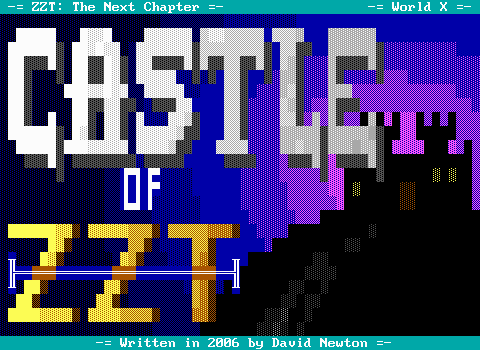There are genres ZZT does well, and genres ZZT does not. When you're working with the latter, there's some leeway given to the challenges of forcing the engine to fit into a system clumsily at best. Working with a more favorable genre comes with its own obstacles. Now you have to deal with perhaps the greatest challenge of all: making your game stand out among the rest. Today we're taking a look at the 1995 fantasy adventure title Warlock Domain by Alan Chan.
From as early as Ezanya, ZZT has been quick to welcome creators to this type of game. ZZT's core features are enough to provide an ASCII Tolkien-esque experience. Within a minute of opening the editor for the first time a new ZZTer can begin making their own Middle Earth, quickly drawing in all the requisite geography. Maze-like Forests, rushing rivers, tall mountains, dark caves, linewall castles fill the realm. A bestiary of foes soon follows. You'll doubtlessly encounter green smiling orcs, ruffian brigands, centipede giant snakes, and so on. Perhaps the most notable substitution due to the rules of ZZT is that most adventurers in such games shun swordplay and "fighter" type default characters opting to turn to a bow and arrows for their protection. The names of ZZT's elements are hidden away in the editor never able to correct an author who chooses to make these already abstract symbols represent something else. A lion can be a lion just as well as they can be a massive ogre or a deadly assassin.
The legacy of these fantasy games in ZZT can't be understated, easily being one of the most plentiful themes around favored just as well by newcomers and by experienced ZZTer alike. The list of featured worlds on the Museum is littered with them. Blood Oath, Defender of Castle Sin, Dragon Eye, Dragon Woods, Dragons, Dungeon Master's Gallery, A Dwarvish-Mead Dream, Ezanya, Fury Spell, Legend of Brandonia, The Mercenary, Mystic Blade, Ned The Knight, Rebirth, Sivion, Warlord's Temple, and of course Warlock Domain itself. It's an incredibly rock-solid genre with countless more examples that never won any awards. It's a genre that works so well with ZZT that even new ZZTers today flock to it (see: Artificer: Rise of the Techmagus).
So where does Warlock Domain fit into this history? What makes it rise to the same level as Ned The Knight? Well, for one thing it's very much a pioneer. Of that huge list of fantasy themed featured worlds, Ezanya is the only title released earlier1. Looking at what came before it across ZZT as a whole, and Warlock Domain is a clear winner that feels years ahead of its time and just as easily stands with (and frankly in many instances surpasses) the many releases of Software Visions. What we have here is a blend of adventure, puzzle solving, RPG combat, with a non-linear structure and multiple endings based on the player's performance. Alan manages to do this with his first ZZT release!
There's quite a lot to this game, and I desperately want to break away from board-by-board coverage so let's break things down and see how this game quickly went from a classic I had never seriously put time into, to easily one of my personal favorite ZZT games out there.
[1] Sivion is dated three months after Warlock Domain, but it's an updated release whose original remains lost. There's definitely a possibility that an original copy of the game to have been released prior to Warlock Domain.

The Title Screen
The title screen is well made, but definitely a bit lengthy. For full effect take a look at it yourself and enjoy the music as well.
The title screen introduces enough to get the player started. You'll be taking on the role of "Penn"; the princesses are "Daisy", "Rose", and "Lily"; "Daimon" is the evil warlock of the domain; and "Alex" and "Milton" are two others who have attempted a rescue and failed. At first it might not sound particularly unique. It comes off sounding like pretty standard stuff, but Chan does an incredible job through Warlock Domain of circumventing these tropes. There's far more to Castle Shadow than finding a few princesses (and adventurers), beating up Daimon and riding off into the sunset.
Content Warning for a single line of dialog that portrays autism in a negative light? The king's description adds in one bizarre detail that rather than being a character trait, the specific wording makes it read as a negative.
"[...] ruled over by a kind ... if marginally autistic... and benevolent King.
As an opening blemish, it's disappointing to see. I'm still really unsure of what to make of it. It's a throwaway line, but framed in a negative light. It's never brought up again, and even when the player gets to speak with the king in some of the game's alternate endings, it's completely irrelevant. It does suck that for a game of this high quality, whose writing is a strong aspect of what makes this game so great, that I very much want everybody play for themselves, that I have to do so with "Oh and uh there's a single off-color line on the title screen?" tacked on to any recommendation.
That's the last of anything of this nature we'll see at least.
The Cast
Penn's exploration of the castle will reveal a lot of details that the title screen purposefully omits. The characters already inside the castle are hardly fantasy stereotypes and every character is memorable.

Penn - Our protagonist who entered the castle to make name for himself. Penn's personality is an interesting one. In many instances Penn's responses can be selected by the player and frequently include blatant machismo options where he threatens to kill the various undead skeleton servants of the warlock Daimon. Yet not once do these options work. The opportunity to let your bow and arrows do the talking never pays off giving the player the impression that Penn has a specific idea of how a hero should act, but is incapable of doing so effectively. Penn never laments the ineffectiveness of these tactics, and the player is ultimately guided to speaking with Penn's true voice rather than imagining what a more typical adventurer would do in the same situation.
Penn can be a little snarky at times when he feels snubbed, but his heart is in the right place.
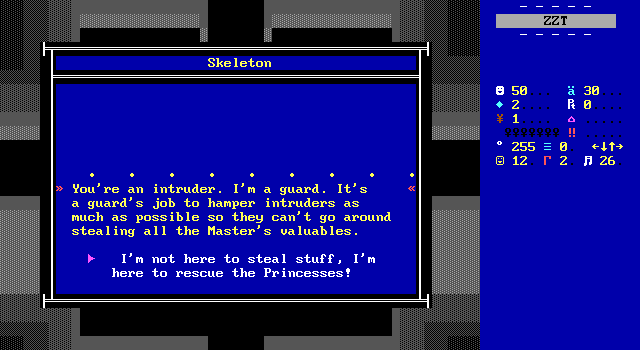
Skeletons - As a warlock, Daimon is skilled in many powerful forms of magic, most notably is necromancy which supplies his castle grounds with a large staff of skeleton guards. They're loyal to their master to varying degrees. Some will attack Penn on sight while others are content to just be a nuisance. One named Feklor even suggests a trade offering up the key to the cell with princess Rose in it in exchange for a magical skull Daimon owns that helps keep his servants ultimately under his control.
These guys are comic relief to be sure with Penn having to figure out how to get past the one guarding the castle gate on the very first board that quickly make it apparent that humor is a major component of Chan's writing, and one he's rather successful at.
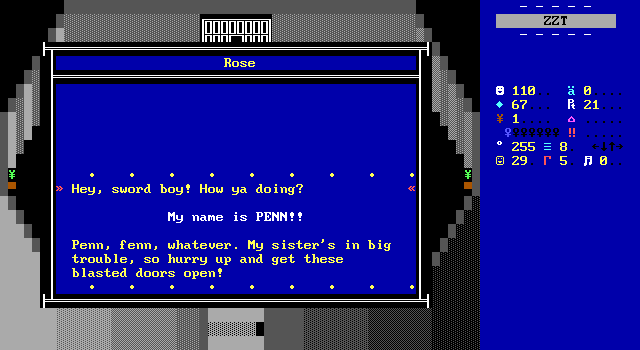
Princess Rose - The king's most headstrong daughter. She's the one who recruited Lily and some royal guards to launch an assault on Castle Shadow. Penn's is introduced to her when he makes it into the dungeon where both she and the rest of the captured guard are being kept prisoner. After opening the dungeon exit, the captain of the guard uses keys he's managed to steal to free the rest of the guards but runs out of keys to open the last cell containing Rose. (They're ZZT keys, 'natch.) A quite frustrated Rose will spends her time running around the perimeter of her cell, repeatedly slamming into its door with the captain hoping that they find another key to get her out sooner rather than later.
Towards the end of the game when the entire group is working together, Rose's relationship with Penn is perhaps a lot like that of princess Zelda and Link from the old Legend of Zelda cartoon, but not nearly as annoying or aggressive. Though they share a common goal Rose is confident that she doesn't need Penn's help and mostly wants him to hurry up already.
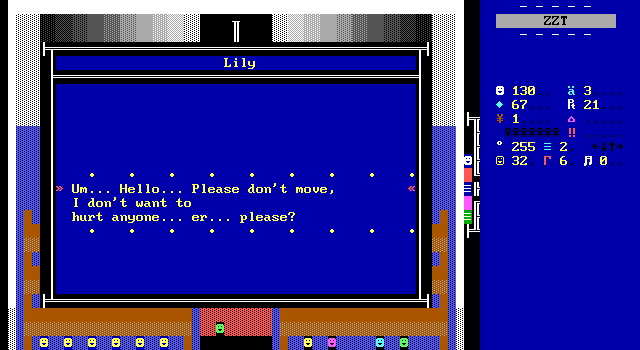
Princess Lily - The much more reserved princess. You get the impression that Rose coerced her into joining the rescue mission. She doesn't fight and is the closest thing this game has to a damsel in distress, but despite her fears she wants to see to it that her sisters come home safely.
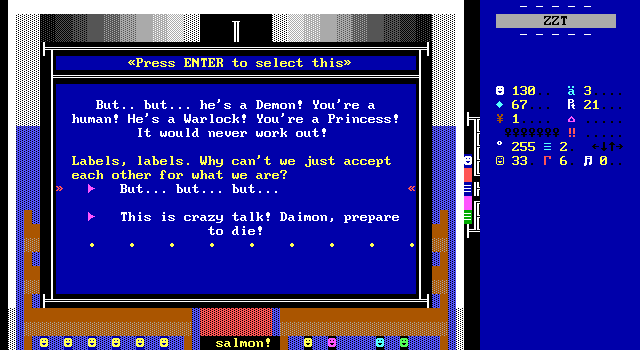
Princess Daisy - The foundation of this whole kidnapping event and the only princess Daimon was specifically after. In due time Penn and the others will learn what Daisy is really up to.
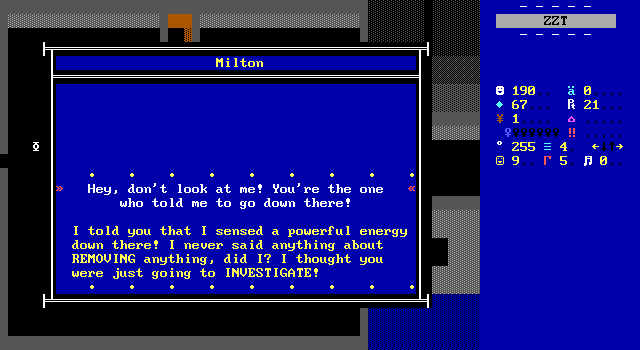
Milton the wanderer - An amateur magician and scholar who funds his studies via adventuring. He was quickly captured by the skeletons and imprisoned in one of the towers. He's also incapable of fighting, having realized that he's in way over his head with this rescue mission. Despite hack of combat prowess he's essential help for Penn and the only character whose rescue is mandatory to get some ending. Milton is useful to Penn not just via the information he provides on how to reach Daimon and helping Penn explore the castle's catacombs, but he's also the one source of healing in the game.
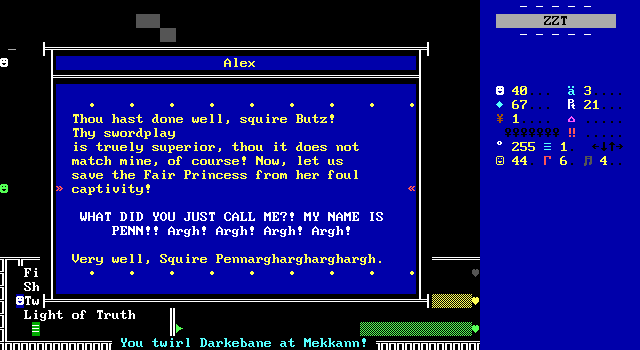
Alex the Knight Paladin - This is Don Quixote. He's overconfident in his abilities, overflowery in his language, and completely incapable of being helpful. At least until combat starts! Despite carrying a shield made of cardboard Alex can hold his own in a fight, unusual as his mannerisms may be. The rest of the group is very much aware of what an idiot he is and isn't hesitant to tell him to shut up already when he keeps prattling on and on...
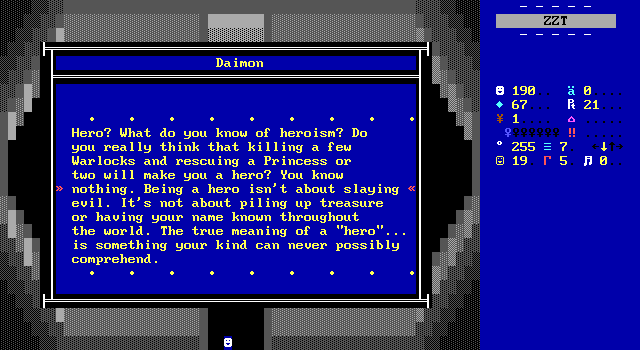
Daimon - The game's antagonist who plans to marry princess Daisy at midnight and take over the kingdom by becoming a part of it. A powerful warlock (with his own domain) capable of powerful magic far beyond the abilities of Milton, Daimon is protective of his castle and will see to it that nobody keeps him from getting what he wants.
Gameplay
Warlock Domain is a tough game to really categorize. The game has been tagged with "Adventure", which is the go-to genre for pretty much every ZZT world out there. In this case it's less a default and more because the game ticks a lot of genre boxes. It is certainly an adventure about Penn's exploration of a dangerous castle with obstacles to overcome and allies to gain. There are some light action elements. A journey through the catacombs beneath the castle has Penn firing his arrows at basic ZZT creatures. There are instances where Alex will have to fight skeletons, bullet-immune lions, and sometimes deal with foes that can't be harmed wither either sword or arrow. Throughout the game there a handful of RPG battles with an engine worth taking a look at in detail. At one point there's an admittedly clunky boss fight where you have to attack by shooting from a magic staff. Warlock Domain has enough humor to be a comedy. It has enough fantasy elements to be err, a fantasy game. Perhaps though, the star of the game may be its puzzles.
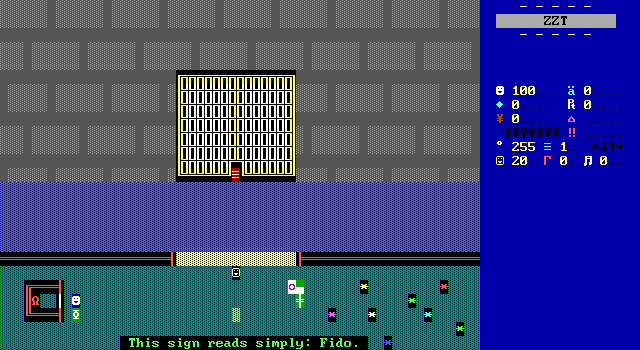
This is made promptly clear to the player whose first task is to find a way to get Penn inside the castle. Armed with only threats, Chan quickly teaches the player that brute force is not going to get you very far. A skeleton guarding the drawbridge, some wildflowers, a locked mailbox, and a sleeping hellhound are all Penn has to work with. The total area the player starts with access to is roughly a third of a board.
Once Penn manages to get inside the game begins in earnest. The main hall splits into three paths, each one leading to a different tower. The middle and main tower is blocked by a magical force-field created by Daimon requiring Penn to find a magical artifact more powerful than Daimon's magic to absorb the barrier. The other paths however are very open to explore. Non-linear games such as this present a lot of challenges. Perhaps most basic is to keep the paths balanced in a way where there isn't a "correct" order. Town of ZZT is a great example of a game that gets this right, while other open-ended games like some of Alexis Janson's earlier titles and LandLand can falter with health and ammo requirements being difficult to reach if you don't do things in a particular way. Chan handles this nicely as these paths themselves aren't point A to point B affairs and quickly branch off into several individual rooms which make it trivial for the player to leave and try something else if they can't get past a certain room.
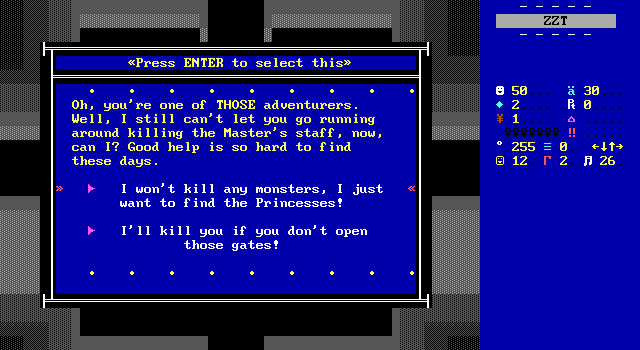
Where the non-linear structure gets more impressive, is that this isn't a journey through empty halls. A lot of game state is tracked via flags. Has Penn acquired a sword? Which one? Is he holding any treasures? Who has he rescued? Who has he killed? What has he read? There's a lot here and the majority of it can be accessed right away. Chan really deserves applause for how well coded this game is as not only does he manage all of this flawlessly, but in many cases the extra detail is more effort than anybody would have expected. My favorite instance of this is one of the skeleton guards accusing Penn of being here to rob the place blind. Penn can rebuff this and explain he's only here for the princesses and has no interest in looting the place which prompts a check for some flags that can result in the skeleton calling him out on the very treasures he's carrying on his person. It's a great mix of code, writing, and creates an element of humor that might go entirely unseen depending on the order the player accomplishes things.
All of the player's actions come to a head at the final battle. Depending on who was rescued, Penn can be fighting solo or with up to three extra allies which dramatically alters the challenge. (Admittedly to a fault, I don't think it's possible to win by yourself short of reloading every time the boss hits you and only continuing when their attacks miss.) The player's actions also change the ending as well. Penn can bring the three girls home safely, but endings are coded for who was rescued, who was left behind, and who was killed.
There's so much variety here that nothing ever feels stale. From start to finish the game is a treat whose few flaws are minor enough to quickly be forgotten. The game is designed in a way where all the boards are sensible, believable locations in an evil warlock's castle which make Penn's journey through it never feel like you're simply playing a ZZT board that happened to get included in this game. Everything has a purpose either in allowing a puzzle to be solving, providing information on the story, or just keeping Penn stocked up on arrows.
Visuals
For a ZZT game from early 1995, Warlock Domain is quite impressive. The architecture of the castle is a bit bland, with nothing but basic dark gray fades to make up the walls. These days, the spartan furnishings of the castle don't really hold up, but they get the job done without question. At various times throughout the game, Chan shows us that he is capable of creating some memorable bits of art, animation, and using multiple objects to better represent things when a single ASCII character won't cut it. The moment Penn steps inside Castle Shadow a seemingly empty main hall comes to life as a large red face appears in front of him. It's Daimon warning him to leave now and be spared or meet his end inside. The effect works great and really showcases how Chan can do quite a lot with just a little. Compare this to Warlord's Temple (a similar title that definitely gets confused with this one on occasion) where the warning to leave is just a sign. Take a look at both and you can see what I mean when I say Chan goes beyond expectations.

Some other moments where Chan pushes his abilities more include a room almost entirely filled by a large sleeping dragon whelp, a flickering magic circle and pentagram, as well as some full sized art boards used for ending cut-scenes. This is an era of ZZT in which is generally pretty simple focused less on combining colors into unique blends and more on "it's brick so it's dark red". The more detailed art boards feel more along the lines of something like Defender of Castle Sin, an RPG praised for its graphics more than three years after Warlock Domain.

Lastly, the game's few RPG battles also include some nice artwork. A fight with a group of skeletons that fuse together into "Skeletor" is particularly impressive as the battle begins with just four white char one skeletons and the actual art having to be revealed from invisible walls, putting extra limitations on the kind of art that can be done using nothing by seven colors of invisibles. The final fight is a monstrous looking creature that a review of the game by Commodore likens to Neo Exdeath from Final Fantasy V. This monstrosity incorporates dripping slime and rising smoke animations into the artwork which brings the last battle to life in a way that the more static visuals of other fights both within this game and elsewhere in other ZZT RPGs don't.
Writing
Saving a princess (or three) from an evil warlock should be pretty cut and dry. I fully expected the only bit of story in this game to be restricted to the title screen. Simply give Penn his motivation and let him get right to it. Instead by the time the player reaches Daimon they'll have learned the origins of the castle, why it was built, the truth about a lost civilization, and so much more, provided of course that they put in the effort to fully explore the castle and get past its many enemies and traps.
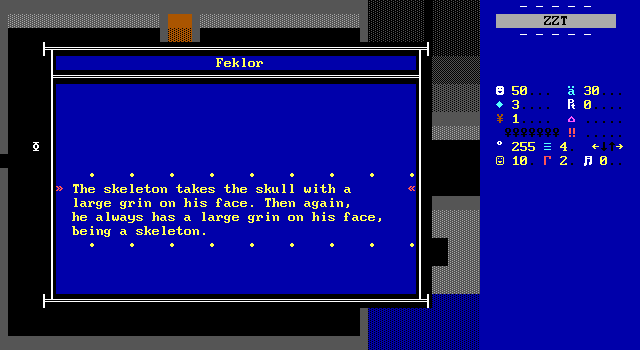
The plot may be fun and definitely more involved than the title screen introduction would have you believe, yet the instances where Warlock Domain's writing are at its best are in the more incidental character interactions. The skeletons give the game plenty of humorous moments which avoids the obvious options of slapstick and puns. The comedic elements are original so don't expect an endless tirade of "No bones about it" or "I've got a bone to pick with you". Since each skeleton is a distinct character, just in a minor role, it helps create an atmosphere of curiosity. Will the next skeleton want to fight? Offer a trade? Flee in terror? Are they loyal to Daimon or is this just a job to pay the bills for them? Not knowing what to expect does a lot to make you want to see how the next encounter with one will play out.
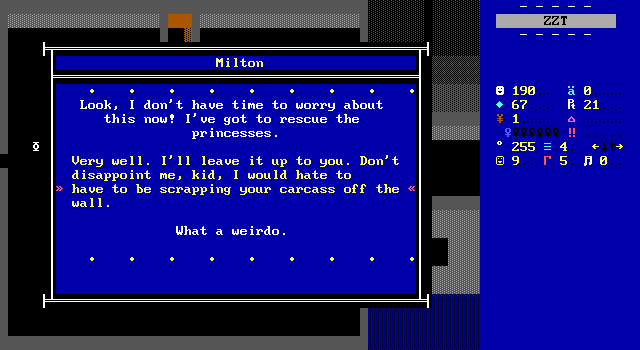
The more prominent cast gets some much better opportunities to shine. Frustrated captured guards seem convinced that Penn won't be any help. Milton the Magician helps put things into perspective. Since he's the only character that Penn actually needs to save in order to finish the game he gets a significant amount of dialog, helpfully explaining how to reach Daimon's tower, while being simultaneously incapable of accomplishing anything useful with his magic. Usually the character that's in way over their head but has to find the courage to keep going is something you'd see from the protagonist. Getting to see that kind of design for a side character makes for a lot of back-and-forth between Milton being essential to the rescue's success and having him be completely useless when there's the slightest resistance.
Princess Lily gets the short end of things. She has almost no dialog and when she's with her sister Rose, Rose pretty much gets to handle all the talking. I wish she got to play some more important role because she winds up really being the generic princess to save that you'd have gotten out of a lesser game in this style.
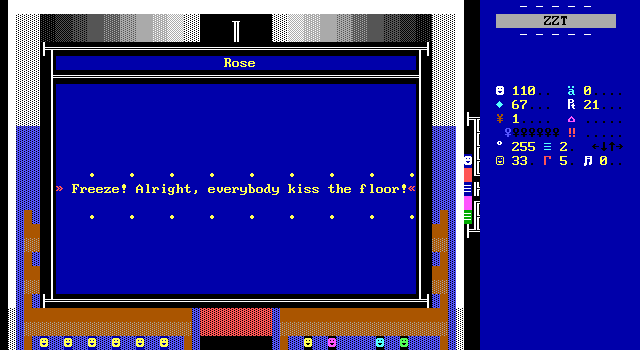
In contrast, Princess Rose gets to be aggressive and confident in herself to nearly a fault. In her few interactions prior to confronting Daimon she's mostly frustrated at having to wait for Penn to move things along. If ZZT had an easy way to do a game over screen, I could totally imagine another ending where getting yourself killed before reaching Daimon but after rescuing Rose from her imprisonment would lead to a cut-scene of her pulling off the rescue on her own. She certainly believes herself able to do so. Despite the rudeness towards Penn initially, by the end the two are both capable warriors who trust each other.
Lastly of the royal family is Daisy who sits in the middle of personality between her sisters Fluttershy and Rainbow Dash. Her inability assert herself and speak up for what she wants is nearly disastrous. Piecing together the various clues about why she was taken by Daimon and not her sisters is essential (and if you've seen the clues, pretty clear) to stopping disaster from befalling the kingdom. It's just the kind of thing that could have been avoided. When she's really in a bind though, she can be just as capable a fighter as Rose.

What really impressed me with the storytelling though was how well structured it was. While Warlock Domain is quite non-linear, that doesn't stop the plot from being revealed sensibly. This works out nicely with Penn's own cockiness that keeps him from ever stopping to think about what's actually going on until the climatic confrontation with the warlock. The player is fed small details: what Daimon plans to do, the history of the castle, a anonymous letter in the mailbox, and even the specific books available in the castle library. These all hint at how the game will end, but do so in a way that the individually pieces don't require knowing any of the others to make sense. When all was said and done, I was really surprised at how much more to this game there really was. Chan builds up this story with each piece being something as rewarding to find as a princess or item to make it past a puzzle. I feel like most ZZT games opt for either a story that's explained in the introduction or for a story that the author thinks could be a series of novels. Chan trim the fat while keeping the player hooked on what detail they'll come across next.
One Wish
This section contains spoilers about what Penn finds in the castle's catacombs!
One of the more unique moments of the game comes from the catacombs. This segment already feels a bit off right away with the game shifting to suddenly using ZZT's default enemies as foes. At first I worried this was just Chan getting bored of making the game, settling for creatures in order to avoid having to do any coding of enemies or come up with more dialog for non-violent encounters. Luckily this fear is cast aside pretty quickly when an underground ziggurat is uncovered, lined with statues making faces of agony. At the top is a small platform with a sword embedded into the ground surrounded by a dark pit that goes on for miles. First I was enamored by the descriptive writing turning a board that was mostly made of empties into a threatening sounding place, but upon claiming the sword the darkness gives way for a massive demon whom Penn inadvertently freed by taking the sword.
The demon prepares to conquer the world and get revenge on those who sealed him away for so long, but not before offering Penn a wish as a favor for freeing him. This of course brings up a list of possible wishes. Sivion has a similar puzzle with its own evil djinn. Here though, Chan puts in a substantial amount of effort. Rather than explain what happens as a consequence of Penn's wish before ending the game (unsurprisingly, none of the wishes work out very well), Chan actually goes so far as to have a generic cut-scene board that shifts in appearance a bit depending on the wish made and provides a unique epilogue animation. Endings are included for wishing Daimon to be dead, wishing to rule the world, and wishing for all the princesses to be with Penn. Of course, these endings are all bad endings with the demon taking over, being hunted down for being responsible for all the world's problems, or in the last case the demon thinking it would be funny to have the princesses transform into demons themselves. The attention to detail is still there though with a dead Daimon ending cutting to the king's throne room and Penn having to explain how he did/didn't save the princesses himself. Chan is thorough to say the least.

